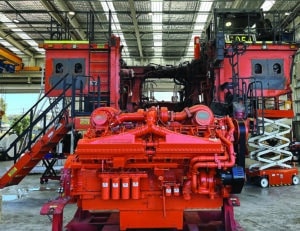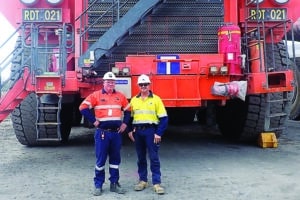A recent project at Whitehaven Coal’s Maules Creek coal mine has seen Cummins repower a fleet of hitachi haul trucks with 2000 horsepower Cummins QSK50 MCRS engines.
Reduced maintenance costs and quality service support are the key reasons Whitehaven is repowering five Hitachi EH3500 haul trucks with 2000 horsepower Cummins QSK50 engines.
The original engines in the EH3500s, from another manufacturer, are being replaced while Hitachi carries out a 32,000-hour refurbishment program on the trucks at its facility in Gunnedah, New South Wales.
The repower project is set to be completed in early 2024.
The repowered trucks, which have a gross weight rating of 322 tonnes carrying a 181-tonne payload, are working at Whitehaven’s Maules Creek mine near Gunnedah, which has annual production approval for 13-million-tonne, or Mt, run-of-mine, or ROM, coal.

Whitehaven, noted for producing high-quality thermal and metallurgical coal, has four operating mines in the Gunnedah Basin which achieved ROM production of 18.2-million-tonne in 2023. More than 100 high-horsepower Cummins engines are involved in its three open-cut operations.
Whitehaven recently announced its plan to buy two major Queensland coal mines from BHP – Daunia and Blackwater – in a multi-billion-dollar deal that will transform it into a leading supplier of metallurgical coal for export markets with pro-forma, ROM production of around 40-million-tonne per annum.
Cummins’ involvement in the Maules Creek operation – currently Whitehaven’s largest mine, which shipped its first coal in 2015 – is significant, with 61 engines in service. These are a mix of QSK50 and QSK60 powerhouses spanning 1944–2850 horse power, all certified to Tier 2 emissions level.
These engines are powering a range of Hitachi equipment, including 45 ultra-class EH5000 haul trucks with a 296-tonne payload and five 800-tonne EX8000 excavators.
Maules Creek is the first mine in the world to implement Hitachi’s autonomous haul truck system. Two autonomous Hitachi excavators are also operating at the mine.
“We’ve had a long, healthy relationship with Cummins,” Whitehaven’s Maules Creek maintenance manager Mark Irwin said.
“We’re familiar with the Cummins product and we get high-quality support, so when the opportunity arose to increase the Cummins footprint at Maules Creek, we jumped at it.
“We can log issues with Cummins and we’re confident those issues will be addressed. There’s a fair bit of comfort in that.”
Cummins Tamworth’s on-site support at Maules Creek is headed up by Phil U’Ren, who is also leading the repower project, a global first for Hitachi and Cummins in that there has been no previous QSK50 repower experience with the EH3500.
“We’ve worked closely with Hitachi on the design, installation and commissioning and it has proved a very successful project,” U’Ren said. “We had to compile a significant parts list and some parts had to be manufactured by Hitachi in Japan specifically for the project.”
Total cost of ownership
When Cummins first got involved in the Maules Creek project during the tender stage, Whitehaven Coal emphasised that the mine had a low-cost business model and total cost of ownership and local service support were the critical elements.
To meet the lifecycle cost requirement for the trucks, collaboration resulted in one engine change-out and one midlife being eliminated from the 90,000–100,000-hour life of the chassis.
All of the engines at Maules Creek incorporate Cummins’ high-pressure modular common rail fuel system, or MCRS, technology for longer life-to-overhaul and reduced fuel consumption and emissions.
“We had high expectations from the start based on our conversations with Cummins and those expectations are being met,” Irwin said.
Irwin pointed out that the life-to-overhaul “starting point” for the QSK50 is 32,000 hours. His experience at another mine site is that 35,000 hours can be “comfortably” achieved with the 50-litre, V16 Cummins in the EH3500.
But discussing life-to-overhaul of the QSK60 rated at 2850 horse power in the 500-tonne EH5000, Irwin revealed 32,000 hours are being achieved comfortably at Maules Creek, and that “we’re exploring pushing that out further”.
“We have to make sure these hours line up with the rest of our maintenance strategies,” he said. “For example, we do a QSK60 change-out at 24,000 hours in the EX8000 excavators and that lines up with the second change-out of their hydraulic pumps for the life of the engine.”

Minimal midlife component change-out is another major cost reduction benefit with the QSK50 and QSK60. The MCRS fuel injectors are achieving full engine life.
“We have over two million hours’ experience with our EH5000 fleet and in that time there has only been single-digit injector replacement before life,” Irwin said. “The MCRS injectors are extremely reliable.”
Low-emission engines are a key requirement at Maules Creek, which operates under strict environmental standards. It is for that reason that all the Cummins engines are Tier 2 emissions compliant.
A fuel consumption improvement in excess of three per cent is calculated for the QSK50 over the engine it replaces in the EH3500, and this results in a significant greenhouse gas reduction for a truck doing 5000–6000 hours a year.
PrevenTech remote monitoring
Another key benefit of repowering with Cummins is the availability of its remote engine monitoring system, PrevenTech, which is connected to all Cummins-powered trucks and excavators at Whitehaven mines.
PrevenTech works by applying connectivity, algorithms and analytics to a machine’s engine hardware, helping a mine identify and diagnose issues faster and more accurately. It works with Internet of Things technology and global security standards.
Irwin saw PrevenTech as a “logical step” for integration in the fleet while the system was being trialled at Maules Creek.
“During the trial period we only had 10 engines connected but still prevented a couple of potentially significant downtime events,” he said. “The machines were diagnosed and then repaired in a short period so as not to interrupt production.
“Anything that helps us get ahead of issues is important. We’ve gone from looking in the rearview mirror to learn from the past, to looking forward and making informed decisions with the real-time data we’re getting from PrevenTech.
“In other words, we’re now being more proactive and less reactive with our maintenance practices and that means reduced operational and maintenance costs.”
This feature appeared in the December 2023 issue of Australian Mining.



.jpg)
